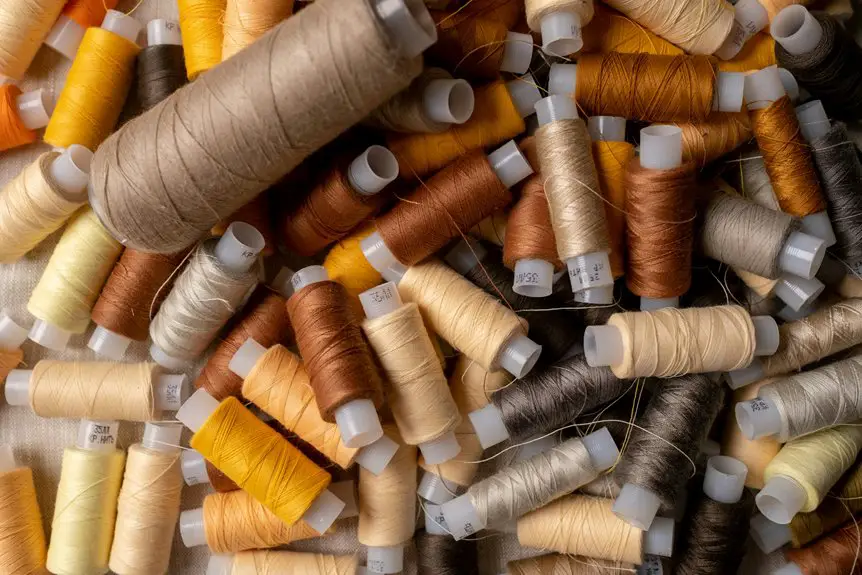You might not realize it, but nylon is actually a specific type of polyamide, made from particular building blocks like hexamethylene diamine. While all nylons are polyamides, not all polyamides are nylon—they vary in chemical structure, affecting flexibility, strength, and melting points. Nylon stands out with high tensile strength and durability, making it popular in textiles and automotive parts. If you want to understand how these materials perform and impact the environment, keep exploring their differences.
Table of Contents
Key Takeaways
- Nylon is a specific type of synthetic polyamide made from hexamethylene diamine and adipic acid, while polyamide is a broader polymer category.
- Polyamides vary in monomer composition, affecting flexibility and melting points, whereas nylon has consistent chemical structure and properties.
- Nylon typically has higher tensile strength and melting point compared to some other polyamide variants.
- Polyamide includes both synthetic and renewable-sourced materials, but nylon production primarily relies on petrochemicals.
- Nylon is widely used in textiles and engineering, while polyamide covers broader applications including carpets, fishing lines, and electrical components.
Chemical Composition and Structure
Although the terms polyamide and nylon are often used interchangeably, they differ in chemical composition and structure.
Polyamide and nylon are distinct in chemical makeup and structure, despite common interchangeable use.
When you look at polyamides, you’ll find they’re a broad category of polymers containing repeating amide groups (-CONH-) in their backbone. Nylon, on the other hand, is a specific type of synthetic polyamide, usually made from hexamethylene diamine and adipic acid (nylon 6,6).
You’ll notice that nylon’s structure features long chains with regular, repeating units, giving it strong intermolecular forces. This regularity makes nylon durable and resistant to wear.
Meanwhile, other polyamides may have varied monomers, affecting flexibility and melting points. Understanding these differences helps you appreciate why nylon performs uniquely compared to other polyamides in textiles and engineering applications.
Manufacturing Processes
Understanding the manufacturing processes behind polyamides and nylon reveals why their properties and uses differ so much.
When you look at nylon, it’s typically made through a condensation polymerization process, where you combine diamines and dicarboxylic acids. This creates long chains with strong amide bonds.
Polyamides, while often referring to nylons, can also include other variations made by different polymerization methods, like ring-opening polymerization, which affects how the polymer chains form.
You’ll find that nylon production usually involves melt spinning, turning molten polymer into fibers.
Polyamides might undergo similar or alternative processing depending on their specific type.
Physical Properties and Performance
The physical properties of polyamides and nylon directly impact their performance in various applications. When you handle nylon, you’ll notice its high tensile strength and excellent abrasion resistance, making it durable under stress.
Polyamides share these traits but can vary depending on their specific chemical structure, affecting flexibility and moisture absorption. Both materials exhibit good thermal resistance, but nylon tends to have a slightly higher melting point, which means it withstands heat better during use.
You’ll also find that polyamides absorb more water, which can influence dimensional stability. Understanding these differences helps you choose the right material for your needs, ensuring peak performance whether you require toughness, flexibility, or heat resistance.
In short, the unique physical properties of each define how they perform in real-world conditions.
Common Applications and Uses
Polyamide and nylon find their way into countless everyday and industrial products because of their versatile properties.
When you pick up sportswear or hosiery, nylon’s elasticity and durability stand out, keeping you comfortable and active. You’ll also find polyamide in carpets, where its resilience helps resist wear and tear.
In automotive parts like gears and bearings, nylon’s strength guarantees long-lasting performance. Polyamide fibers are common in fishing lines and ropes, thanks to their high tensile strength.
If you handle electrical components or plumbing fittings, polyamide’s insulating and chemical-resistant features come into play.
Environmental Impact and Sustainability
Although nylon offers impressive durability, its production and disposal pose significant environmental challenges you should consider.
Nylon is derived from petrochemicals, which means it relies on non-renewable resources and emits greenhouse gases during manufacturing. When disposed of, nylon takes years to decompose, contributing to landfill waste and microplastic pollution.
Polyamide shares many of these concerns, but some variants can be sourced from renewable materials, offering slightly greener alternatives.
To minimize environmental impact, you should focus on:
- Choosing recycled polyamide or nylon products
- Supporting brands with sustainable manufacturing processes
- Properly recycling or repurposing nylon materials
- Advocating for innovations in biodegradable polyamides
Frequently Asked Questions
Is Nylon the Same as Polyamide in Everyday Language?
You might think nylon and polyamide are different, but they’re actually the same in everyday language. Nylon is just a type of polyamide, so when you hear either term, they often refer to the same synthetic fiber.
Can Polyamide or Nylon Cause Allergic Reactions?
Yes, you can experience allergic reactions from polyamide or nylon, especially if you have sensitive skin. These materials sometimes contain additives or chemicals that trigger irritation, so it’s best to test before prolonged exposure.
How Do Polyamide and Nylon Compare in Cost for Consumers?
You’ll find polyamide and nylon costs pretty similar, but nylon often comes slightly cheaper due to mass production. However, prices vary based on quality and brand, so always compare before buying to get the best deal.
Are Polyamide and Nylon Recyclable at Home?
You might be surprised—recycling polyamide and nylon at home isn’t straightforward. They require special processes, so tossing them in your regular bin won’t work. Instead, look for local textile recycling programs to handle them properly.
Which Fabric Feels Softer, Polyamide or Nylon?
You’ll find nylon generally feels softer and smoother against your skin compared to polyamide. Nylon’s finer fibers give it a silkier touch, making it more comfortable for clothing, while polyamide can feel a bit rougher.







